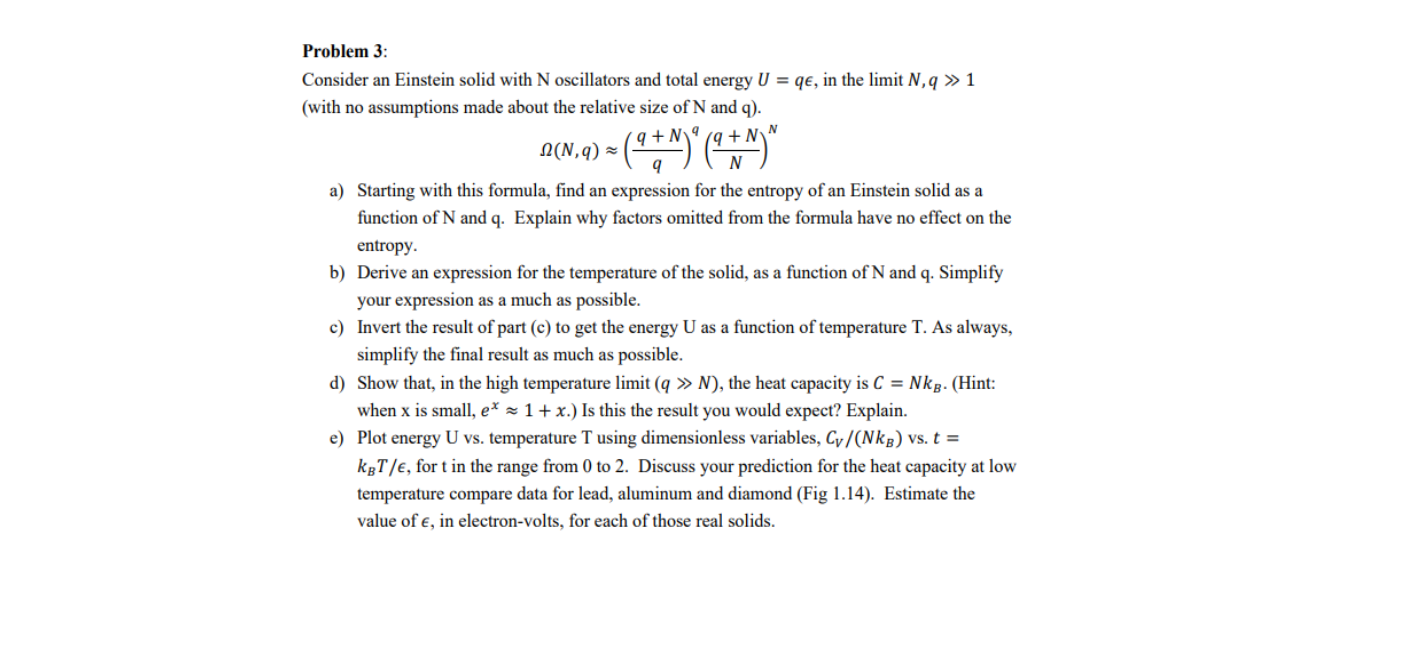Problem 3: Consider an Einstein solid with N oscillators and total energy U = qe, in the limit N,q » 1 (with no assumptions made about the relative size of N and q). + N° (9 +N\9 a) Starting with this formula, find an expression for the entropy of an Einstein solid as a function of N and q. Explain why factors omitted from the formula have no effect on the entropy. b) Derive an expression for the temperature of the solid, as a function of N and q. Simplify your expression as a much as possible. c) Invert the result of part (c) to get the energy U as a function of temperature T. As always, simplify the final result as much as possible. d) Show that, in the high temperature limit (q » N), the heat capacity is C = Nkg. (Hint: when x is small, e* = 1+ x.) Is this the result you would expect? Explain. e) Plot energy U vs. temperature T using dimensionless variables, Cy/(Nkg) vs. t = kgT/e, for t in the range from 0 to 2. Discuss your prediction for the heat capacity at low temperature compare data for lead, aluminum and diamond (Fig 1.14). Estimate the value of e, in electron-volts, for each of those real solids.
Problem 3: Consider an Einstein solid with N oscillators and total energy U = qe, in the limit N,q » 1 (with no assumptions made about the relative size of N and q). + N° (9 +N\9 a) Starting with this formula, find an expression for the entropy of an Einstein solid as a function of N and q. Explain why factors omitted from the formula have no effect on the entropy. b) Derive an expression for the temperature of the solid, as a function of N and q. Simplify your expression as a much as possible. c) Invert the result of part (c) to get the energy U as a function of temperature T. As always, simplify the final result as much as possible. d) Show that, in the high temperature limit (q » N), the heat capacity is C = Nkg. (Hint: when x is small, e* = 1+ x.) Is this the result you would expect? Explain. e) Plot energy U vs. temperature T using dimensionless variables, Cy/(Nkg) vs. t = kgT/e, for t in the range from 0 to 2. Discuss your prediction for the heat capacity at low temperature compare data for lead, aluminum and diamond (Fig 1.14). Estimate the value of e, in electron-volts, for each of those real solids.
Related questions
Question

Transcribed Image Text:Problem 3:
Consider an Einstein solid with N oscillators and total energy U = qe, in the limit N,q » 1
(with no assumptions made about the relative size of N and q).
+ N°
(9 +N\9
a) Starting with this formula, find an expression for the entropy of an Einstein solid as a
function of N and q. Explain why factors omitted from the formula have no effect on the
entropy.
b) Derive an expression for the temperature of the solid, as a function of N and q. Simplify
your expression as a much as possible.
c) Invert the result of part (c) to get the energy U as a function of temperature T. As always,
simplify the final result as much as possible.
d) Show that, in the high temperature limit (q » N), the heat capacity is C = Nkg. (Hint:
when x is small, e* = 1+ x.) Is this the result you would expect? Explain.
e) Plot energy U vs. temperature T using dimensionless variables, Cy/(Nkg) vs. t =
kgT/e, for t in the range from 0 to 2. Discuss your prediction for the heat capacity at low
temperature compare data for lead, aluminum and diamond (Fig 1.14). Estimate the
value of e, in electron-volts, for each of those real solids.
Expert Solution
This question has been solved!
Explore an expertly crafted, step-by-step solution for a thorough understanding of key concepts.
This is a popular solution!
Trending now
This is a popular solution!
Step by step
Solved in 6 steps with 6 images
